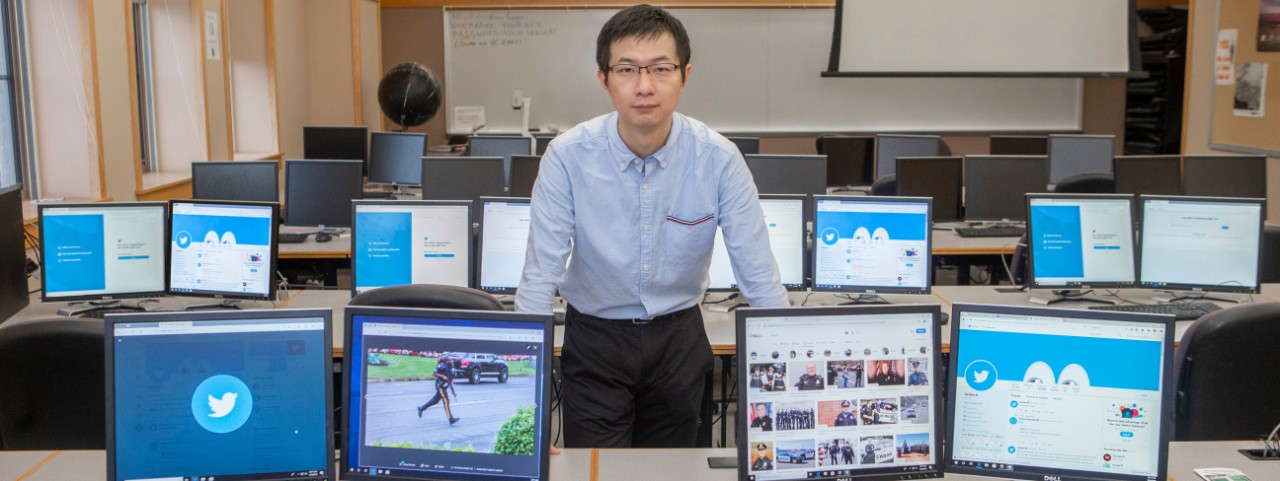
Tweets and punishment: UC study finds social media better than U.S. census at predicting crime
Geographers found a correlation between theft reports and social media check-ins
What’s a better predictor of petty crime than population figures?
Tweets.
University of Cincinnati geography researchers found that Twitter was a better gauge of where petty crimes were likely to occur than population data from the U.S. Census Bureau.
The reason? Census figures show only where people reside while Twitter can tell you where people are spending their waking hours, lead author and UC graduate assistant Minxuan Lan said.
“Crimes like theft are more likely to be related to where people really are, not where they live,” he said.
Researchers call this the “ambient population.” And since crime rates are typically calculated using census figures, social media could help law enforcement understand why crimes are happening in less populated areas, Lan said.
The study was published in the journal Sustainability.
The project demonstrates UC's commitment to research as part of its strategic direction called Next Lives Here.

UC geography student Minxuan Lan checks his Twitter feed on campus. He and his co-authors found that social media was more useful than the census in finding out where people were spending their time. Photo/Joseph Fuqua II/UC Creative Services
Students in UC’s College of Arts and Sciences examined a year’s worth of theft statistics along with public social media posts. They weren’t interested in social media content, just the geotagged locations.
They applied a mathematical model called negative binomial regression to study the ambient population derived from tweets as well as its “spillover effect” on crimes of theft. The spillover effect detects information on Twitter users’ mobility embedded in their tweets.
They found that tweets outperformed census numbers in analyzing spatial theft patterns. Tweets showed a significant spillover effect on thefts, unlike the census figures.
“It may apply to any city,” Lan said. “We use public geotagged tweets to measure the dynamic population distribution. We found a correlation between tweets derived from the ambient population and theft.”
Knowing where people are during the day can be very useful in explaining health-related issues.
Lin Liu, UC geography professor
The results are consistent with previous geography research that examined correlations between social media and crime. For example, researchers at the University of Tennessee Knoxville found a correlation between petty crime and social media check-ins on Facebook and tweets on days when the Tennessee Volunteers played home football games.
UC geography professor Lin Liu said data from social media has its limitations. Unlike census figures which attempt to account for everyone, Twitter isn’t representative of the entire population. Users are both younger and more likely to live in urban areas than the general population.
“I go to the extreme of saying all social media data are biased. Bias related to age is the biggest issue. Young college-age people take the lion’s share,” he said.
Likewise, just 4% of Twitter users share their locations when posting, which presents additional limitations. And users often share their locations selectively, the study found.

UC student Minxuan Lan
But Liu said social media could have predictive value to help law enforcement direct resources where they’re most needed. And real-time posts combined with a vast dataset could make social media useful in tracking other social issues such as public health, he said.
“If you’re studying public health, you could look at exposure risk to disease. You don’t face exposure in the home. You get exposed when you go to work or buy groceries,” he said. “Knowing where people are during the day can be very useful in explaining health-related issues.”
The study was funded by the National Natural Science Foundation of China and a UC research fellowship.
“We are trying to find where people are at a particular time. Social media could help us. It has finer temporal resolution,” Lan said, referring to the amount of time needed to revisit and acquire data for the exact same location. “Tweets can be posted at any time of the day.”
Lan said next he would like to see if he can get finer temporal resolution to identify particular days or times when these correlations are strongest.
Featured image at top: UC geography student Minxuan Lan is studying what social media can tell us about society. Photo/Joseph Fuqua II/UC Creative Services

Minxuan Lan stands in a UC geography computer lab. He is studying what social media can tell us about society. Photo/Joseph Fuqua II/UC Creative Services
More UC geography news
Next Lives Here
The University of Cincinnati is classified as a Research 1 institution by the Carnegie Commission and is ranked in the National Science Foundation's Top-35 public research universities. UC's graduate students and faculty investigate problems and innovate solutions with real-world impact. Next Lives Here.
Become a Bearcat
- Apply online or get more information about undergraduate enrollment by calling 513-556-1100.
- Learn more about UC's many undergraduate and graduate programs.
Related Stories
Mayor Pureval, Rob Richardson lead ethical AI symposium
July 5, 2024
As artificial intelligence rapidly integrates into everyday life, Rob Richardson, CEO and founder of Disrupt Now and MidwestCon and local tech startup partner of the University of Cincinnati 1819 Innovation Hub, recently spearheaded the Responsible AI Symposium with Cincinnati Mayor Aftab Pureval, calling upon community leaders to discuss and ensure artificial intelligence technologies help users rather than harm.
How to keep birds from flying into your windows
July 3, 2024
UC College of Arts and Sciences professor Ron Canterbury tells the Indianapolis Star that simple steps can prevent birds from strike windows around your home or business. Yahoo! News shares the story.
UC’s microchip training includes innovative VR
July 2, 2024
To build a virtual microchip factory, University of Cincinnati doctoral students turned to the real one where they work. UC launched a new training program for microchip manufacturing in advance of the new fabrication plant Intel Corp. is opening in Ohio.
